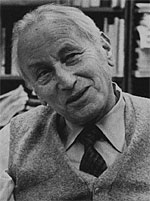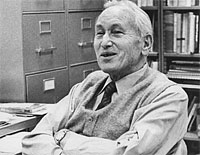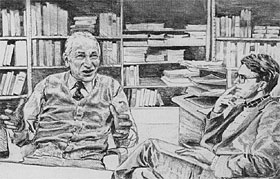Interview: Kenneth Thimann

Kenneth Thimann, now professor emeritus at the University of California, Santa Cruz, has had an important influence on the development of plant physiology. A pioneer in the field of plant hormones, Dr. Thimann was a key member of the research team that was first to identify and synthesize auxin, a hormone that regulates plant growth. He followed that achievement with many others and is currently investigating the mechanisms that control aging of plants. Throughout his career, Dr. Thimann has been interested in the agricultural implications of basic research in plant science. His concern with feeding the world's ballooning population is highlighted in this interview.
Dr. Thimann, what led you to a career in plant science?
Well, it wasn't really planned. As an undergraduate, I was always interested in biology and thought that studying chemistry was the way to approach it. When I left England and went to Cal Tech as a young man, my first job was in biochemistry. At Cal Tech, I met a young man from Holland, Herman Dolk, who proposed that we make a joint attack on what was then a hypothetical growth substance in plants. He would be the botanist and I would be the chemist of the team. But after we got going, Herman Dolk was killed in an auto accident, so I had to become the plant biologist as well as the chemist.
Do you ever regret that these events focused your research interests on plants rather than animals?
I don't now, but I have in the past, because animal research is much better funded and generally brings more recognition. But now I don't feel that way at all because of the relevance of plant research to the immediate needs of humanity. Some parts of the world are going to suffer a continuing food shortage for many years. I think all the time of how my basic research can be oriented to do some good for world food problems.
Before we talk about the agricultural applications of plant physiology, I'd like to ask you a few basic questions about plant form and function. Besides photosynthesis, what processes most distinguish plants from animals?
Growth is a very strangely different affair in plants and animals. Cell enlargement plays such an important part in plants but only a minor part in animal growth. Plants grow mainly by their individual cells taking up water. Changes in the cell wall are also important to growth. In fact, the presence of cell walls makes plants fundamentally different from animals in organization and physiology. On the other hand, plants and animals are very much alike in their basic molecular processes and metabolism — except for photosynthesis, of course.
And both plants and animals use hormones as chemical signals controlling growth and development. To an observer, the chemical control of plants is perplexing, partly because one hormone can have very different effects on different kinds of plants, on different parts of the same plant, and on the same part at different stages of development. Are there any general themes of hormone action that can simplify this picture?

Well, one substance does seem to have a wide variety of effects, and it's very hard to nail them all down to one particular cellular or metabolic mechanism. I suppose the big simplification will come when we know the ultimate site of action. Then we shall see how this one effect could have multiple results depending on the situation. For instance, one site of action of the hormone auxin is the proton pump located at the plasma membrane of plant cells. Stimulation of this pump changes the chemistry of the cell wall, and this seems to be one way auxin causes cells to elongate. But a different effect of auxin, such as formation of roots on cuttings, may have no connection to proton pumps; the cellular site of action and primary response to auxin may be completely different. More research will help to clear up the picture.
Could you give some examples of discoveries from basic plant research that have been applied to agriculture?
My own field of plant hormones has had a tremendous influence on agriculture. Plant hormones are used today to stimulate cuttings of plants to root and also to control ripening of fruit. And some of the herbicides important in agriculture are chemically related to natural plant hormones. But when we began to characterize the hormone auxin, we didn't have herbicides in mind. Practical applications of basic research are impossible to predict.
The use of herbicides is one of the more controversial applications. How do you respond to critics concerned about the environmental impact of the herbicides used in agriculture?
As far as 2-4D and other herbicides that are chemical analogs of auxins are concerned, I see no problem. These substances are active on plants at concentrations much too small to have any known effects on humans or other animals. And herbicides are actually helping to solve one problem that concerns environmentalists: the problem of erosion. Plowing farmland, especially sloped fields, contributes to erosion. Many farmers are trying "low-till" methods that require a minimum of plowing. But these methods only work if herbicides are used to kill weeds.
Advocates of "organic" farming also criticize the application of commercially produced fertilizers. Is there anything more healthful about organically grown foods compared with commercial produce?
This is a question that students ask me all the time. I point out that manure and other organic fertilizers are taken up by plants only after they are converted in the soil to inorganic minerals. So whether you add essential nutrients to the soil in organic or inorganic form, the plant gets the same minerals. Both types of fertilizers have certain advantages and disadvantages. But as far as food value is concerned, it makes no difference. Several studies have shown that plants grown on commercial fertilizers have the same content of vitamins and other nutrients as plants grown on natural fertilizers.
Environmental issues aside, there is general agreement that modern agricultural methods have increased food production tremendously. As one of the few countries still able to grow more food than it needs, do we have a responsibility to push toward even greater food production?

Oh, yes! I think all eyes are on the United States as far as food is concerned. We even send food to Russia and other countries with which we have very cool relations otherwise, partly because the farmers want to sell the food, but partly I think because we recognize our great responsibility. We're feeding half the world. Of course, we can't go on raising our yields indefinitely. We're currently using about all the available land, and we're close to saturation with fertilizers. So now what we have to export is expertise to raise food in the other parts of the world. We have plenty of people to do that, and we should be doing it more, providing the other countries invite us.
You mentioned there are limits to how much food we can grow. Given a fixed amount of arable land and the best available agricultural technology, crop yields would be limited by the efficiency of photosynthesis. Are there ways we could improve photosynthetic output?
The limit is that when we have full sun we can't supply enough CO2. Plants could take in and use three or four times the amount of CO2 in the air. Some interesting work is being done at DuPont, trying to supply CO2 to plants in the field. The trouble is, you see, that CO2 is a gas and a breath of wind comes and takes it all away. If anyone could work out a system for supplying CO2, it would have a big effect on agricultural yields. I would also like to see more work done on CAM plants. You know, these are the plants that fix CO2 in the dark and then use it in the light. [The CAM pathway of photosynthesis is described in chapter 10. ] The only CAM plant we have that's cultivated is the pineapple, and it's not exactly a major crop. I'd like to see some breeding done: try to raise some CAM plants with high nitrogen content or edible leaves. I believe this could be a very exciting field, though it would take many years, of course. But CAM plants are especially good for arid land, with which we're cursed as are Africa and China.
Should we be searching for wild plants that could be cultivated as future food sources?
Existing crop plants are pretty good, and as they're constantly improved by the breeders, they have tremendous yields. When we bring in wild plants, we have to do an awful lot of work to tame them, to get high yields under agricultural conditions. I think it's important, but it's pretty long-range stuff. I don't think it will yield much contribution to the present world food supply. It's important to do in any case, because like all pure research, you can't predict how far it will go. I'm fond of saying that one of the biggest contributions to medicine, saving more lives than almost any drug or antibiotic, is the telephone. You can't lay down a rule as to what kind of research is worth pursuing.
Speaking of research, Dr. Thimann, what advice can you offer undergraduate students with a budding interest in research?
I urge people who think they might go on in science to get a taste of research, get into somebody's lab and do a bit of research. There's absolutely no substitute for the excitement of things happening in the lab. Here at Santa Cruz we take undergraduates in the lab, and many other campuses are doing it more and more. I like to see it. It has to be limited, tailored to specific individuals who are motivated, but it's a real excitement that you can't substitute anything else for.
©2005 Pearson Education, Inc., publishing as Benjamin Cummings